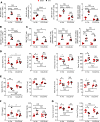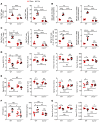Ovariectomy induces bone loss via microbial-dependent trafficking of intestinal TNF+ T cells and Th17 cells
- PMID: 33586672
- PMCID: PMC7880410
- DOI: 10.1172/JCI143137
Ovariectomy induces bone loss via microbial-dependent trafficking of intestinal TNF+ T cells and Th17 cells
Abstract
Estrogen deficiency causes a gut microbiome-dependent expansion of BM Th17 cells and TNF-α-producing T cells. The resulting increased BM levels of IL-17a (IL-17) and TNF stimulate RANKL expression and activity, causing bone loss. However, the origin of BM Th17 cells and TNF+ T cells is unknown. Here, we show that ovariectomy (ovx) expanded intestinal Th17 cells and TNF+ T cells, increased their S1P receptor 1-mediated (S1PR1-mediated) egress from the intestine, and enhanced their subsequent influx into the BM through CXCR3- and CCL20-mediated mechanisms. Demonstrating the functional relevance of T cell trafficking, blockade of Th17 cell and TNF+ T cell egress from the gut or their influx into the BM prevented ovx-induced bone loss. Therefore, intestinal T cells are a proximal target of sex steroid deficiency relevant for bone loss. Blockade of intestinal T cell migration may represent a therapeutic strategy for the treatment of postmenopausal bone loss.
Keywords: Bone Biology; Bone disease; Bone marrow; T cells.
Conflict of interest statement
Figures





Comment in
-
From the gut to bone: connecting the gut microbiota with Th17 T lymphocytes and postmenopausal osteoporosis.J Clin Invest. 2021 Mar 1;131(5):e146619. doi: 10.1172/JCI146619. J Clin Invest. 2021. PMID: 33645543 Free PMC article.
References
-
- Khosla S, Pacifici R. In: Marcus R, Feldman D, Dempster DW, Luckey M, Cauley JA eds. Osteoporosis. Amsterdam: Elsvierer; 2013:1113–1138.
Publication types
MeSH terms
Substances
Grants and funding
LinkOut - more resources
Full Text Sources
Other Literature Sources
Molecular Biology Databases

